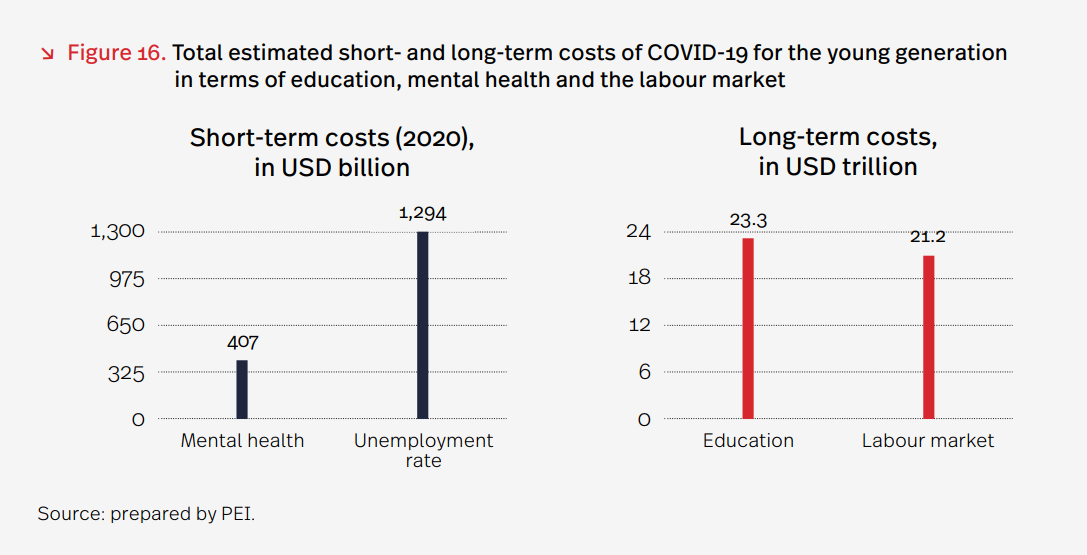Global long-term costs of the pandemic for young people are USD 44 trillion

Published: 16/03/2021
Education, the labour market and mental health are three areas where the young generation will be hit the hardest by COVID-19.
Short-term costs on a global scale are USD 1.7 trillion. Those include costs relating to mental health (USD 407 billion) and youth unemployment (USD 1.3 trillion). The long-term impact of the pandemic on education and the labour market will involve much higher costs – an estimated amount of USD 44 trillion. As regards education, the anticipated loss of earnings of 6.2 per cent will last the whole working life of the young generation, i.e. approx. 45 years. Long-term effects on the labour market will include young workers’ earning 4 per cent less than in ‘normal’ times for 15 years. Those are the findings from the report entitled ‘Corona generation. Growing up in a pandemic’ prepared by the Polish Economic Institute.
The costs of the COVID-19 pandemic for the young generation are broken down into 3 areas: education, health and the labour market. As shown by the analysis, short-term costs will total USD 1.7 trillion and include costs relating to mental health and increased youth unemployment. The most important element of the estimated amount of long-term costs of USD 44 trillion will be USD 21 trillion in future earnings lost as a result of limited access to education, measured over young workers’ 45-year careers. Other crucial components will be costs of increased permanent unemployment, at USD 15.5 trillion, and a fall in young workers’ earnings by USD 5.7 trillion in the coming 15 years.
The educational loss will make the post-pandemic labour market less friendly
The pandemic-related educational loss is primarily due to factors such as temporary or permanent school closures, remote lessons – which research suggests are a less effective form of teaching than traditional ones – and widened educational disparities between disadvantaged and more privileged social groups. Depending on the cultural context, young women may suffer greater educational losses in selected countries and regions.
Young workers have been particularly affected by the corona crisis. In 2020, the world’s unemployment increased by 3.7 per cent, whereas youth unemployment went up by as much as 8.7 per cent. Among those most vulnerable during the COVID-19 crisis are the 1.6 billion informal economy workers. They represent half of the global workforce and work in sectors experiencing major job and revenue losses. In 2020, the total financial costs for young people were USD 1.3 trillion, which corresponded to 1.5 per cent of global GDP.
Today’s representatives of the young generation are estimated to have over 6 per cent lower future earnings in connection with the repercussions of the pandemic. Individuals working in high-income economies will be particularly affected as the net present value loss in earnings will amount to USD 750 each year. As regards medium-income economies, the amount lost will range from USD 420 to USD 510, whereas in low-income countries the loss will be USD 400. If we add up lost future earnings of young people, the annual amount will be USD 465.8 billion, the equivalent of more than 0.5% of global GDP; with regard to a whole working lifecycle (45 years), young people will earn nearly USD 21 trillion less due to COVID-19. Interestingly, university graduates will suffer the highest losses: USD 56,000 for men and USD 43,000 for women.
Costly deterioration in mental health
In addition to deteriorated circumstances for individuals and related social costs, decreased mental well-being entails measurable economic costs. The overall annual increase in costs due to COVID-19-related mental health problems among young people is estimated at 0.49% of GDP worldwide, i.e. USD 407 billion. That amount will include USD 185.5 billion in additional direct spending on health systems, USD 79.6 billion spent on improving social security programmes and a further USD 141.9 billion USD in indirect costs related to lower employment and decreased productivity.
The young generation’s mental health has been mostly deteriorated by reduced labour market opportunities, worse prospects for stable employment, consequences of social isolation and stress resulting from potential effects of becoming infected with the coronavirus. At the same time, adverse initial labour market entry involves various social risks, including fewer marriages, more divorces, reduced fertility, increased social pathologies led by crime or alcohol abuse. Several other healthcare-related problems can be observed as well. Those primarily include access to specialists (psychiatrists, psychologists and therapists), the number of abandoned hospitalisations of mentally ill patients and an adverse effect of COVID-19 on the quality of therapy for people with mental disorders. The costs of COVID-19 related to mental health problems vary between regions and range from 0.53% of GDP in the Middle East and in Africa, 0.52% of GDP in East Asia and the Pacific, 0.49% of GDP in Europe and Central Asia, 0.44% of GDP in North America, 0.41% of GDP in Latin America and the Caribbean to 0.38% of GDP in South Asia.
How do we mitigate the effects of the corona crisis on young people?
Although it is impossible to eliminate the costs of the COVID-19 pandemic and its impact on young people’s situation, various measures may be implemented to mitigate the adverse effects of the corona crisis. Firstly, a key component will be higher expenditure on education and an accompanying programme for catching up in terms of knowledge, skills and qualifications of the young generation. It is a pre-requisite for young people’s future competitiveness on the labour market. In addition, growth in spending on mental health is crucial. As shown by a snowballing increase in mental health problems resulting from the pandemic situation among young people, avoiding a lost generation will involve strengthening not only the healthcare segments directly treating COVID-19 infections but also those offering mental health support.
‘It is necessary to further pursue counter-cyclical policy in the form of fiscal stimulation aimed to reduce youth unemployment. The policy package should comprise measures such as wage-subsidy programmes, extended direct support for enterprises and active labour market policies promoting skills currently in demand. It will allow avoiding negative effects of long-term unemployment, whether for the economy as a whole, in the form of a weakened future bounce-back, or as a shock for the young generation entering social and working life. Governments should focus on building foundations for their economies’ future resilience to various shocks’, says Krzysztof Kutwa, an analyst of the strategy team of the Polish Economic Institute.
The Polish Economic Institute is a public economic think-tank dating back to 1928. Its research spans foreign trade, macroeconomics, energy and the digital economy, with strategic analyses on key areas of social and public life in Poland. The Institute provides analysis and expertise for the implementation of the Strategy for Responsible Development and helps popularise Polish economic and social research in the country and abroad.
Media contact:
Ewa Balicka-Sawiak
Press Spokesperson
T: 48 727 427 918
Kategoria: Press releases / Report / Reports 2021 / Sustainable Development






